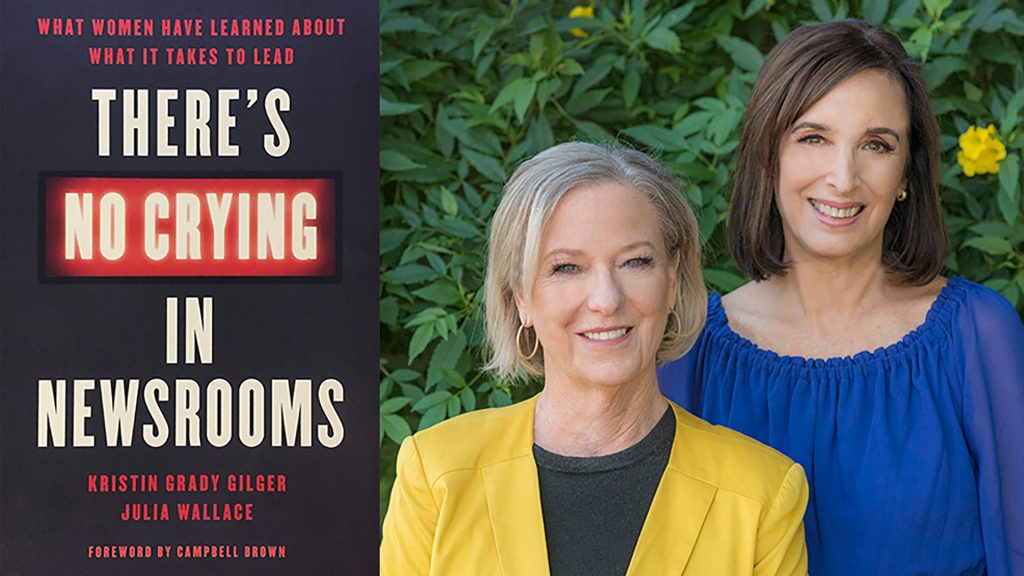Are the women in your newsroom the key to driving innovation?


How do you measure gender diversity in your newsroom? Probably by the numbers, right? And by moving more women into positions of power.
By those standards, there’s been progress for women in local TV newsrooms. According to Hofstra Professor Emeritus Bob Papper’s annual survey for the RTDNA, more than one-third of news directors — 35.3% — are women. In the top 25 markets, it’s nearly half (47.6%), Those are record highs, even if there’s obviously still a lot of room for improvement. And nearly a quarter (23.4%) of general managers of stations that produce local news are women.
But the authors of a new book, There’s No Crying In Newsrooms: What Women Have Learned About What It Takes To Lead, suggest that statistical diversity isn’t sufficient, and that true culture change may be critical if stations are to unleash the full potential of women leaders and adapt to a new generation of colleagues and consumers.
Kristin Gilger and Julia Wallace, faculty stars with multiple roles at the Walter Cronkite School of Journalism at ASU, have decades of experience as high-level news managers. I’m a bit biased, because they are colleagues at Cronkite and interviewed me for one of the book’s chapters, but their book is filled with fascinating case studies of women who fought to make it in the male-dominated news world, as well as excellent advice for women working their way up in newsrooms today.
I had a chance to chat with Gilger and Wallace about what they learned from writing There’s No Crying in Newsrooms. Here are five takeaways from our conversation that I found especially relevant to the new generation of local TV newsroom leaders.
1. “We didn’t do enough. We fit into the culture and didn’t change it.”
You might think that as members of a generation of women who helped pave the way for today’s newsroom leaders, Gilger and Wallace would take a victory lap. In fact, it’s quite the opposite. “I really felt at the end of this like I needed to apologize to the entire generation of women coming up in newsrooms today, because we didn’t do enough,” Gilger says. “Our approach was to keep your head down, work really hard, be better than everybody else, stick it out, bring other women up behind you. And we thought that would change things, that it was a matter of time and numbers and persistence. And I don’t think I was right about that.”
The #MeToo movement shines a harsh light on the past and shows how much work still needs to be done, but the issues go well beyond sexual harassment to the fundamental role of women as newsroom leaders.
“Our generation was too focused on fitting into the culture that existed,” says Wallace, “figuring out how we had to navigate that, as opposed to saying, ‘That’s crazy. Let’s talk differently.’”
“A lot of women from our generation just managed like the guys,” says Gilger.
2. “Until we understand that we really, really need a more collaborative and nurturing environment in newsrooms, we’re not going to make progress.”
Wallace calls this “the hard work of culture change,” and she acknowledges that it’s rarely a newsroom’s top priority given the press of daily news coverage. But Gilger agrees with research that says “younger people will respond better to a slightly more nurturing, more communicative, less authoritarian, less top-down style.” The authors are careful not to generalize about the characteristics of women leaders, but the message is obvious: managing “like the guys” isn’t going to work as well with a new generation of employees — women and men alike.
3. “You need to create your own narrative in the workplace.”
I’ve always felt there was too much stylistic conformity among news directors (and doubly so for GM’s), although I’m not sure whether that’s a function of natural selection (certain types get ahead in the homogeneous corporate world) or just self-selection (certain types are attracted to these jobs). But Gilger and Wallace make the compelling point that the path to leadership for women is even narrower than for men, the penalties for straying outside the lines much more severe. A man can have a temper tantrum, be fine the next day, and all is forgiven; for a woman, that becomes part of the “narrative” that frames her forever.
“You need to create your own narrative in the workplace,” says Gilger, “because people are less inclined to accept a woman in a leadership role. And that means that the stories about you in the workplace related to your role as a leader are even more powerful than usual.” “And they can turn negative really fast for women,” adds Wallace. “It’s why women get called bitches.”
It’s a tricky balancing act, the authors say. It’s much harder for women to be tough and direct — qualities generally seen as virtues in male leaders. “Over and over in interviews, women told us they felt they had to moderate their behavior,” says Gilger. But there’s also a risk for women of being perceived as too nurturing, not tough enough. “You’re seen as a pushover. you’re seen as somebody who other people can sort of take control of,” says Wallace.
Think about how the United States women’s national soccer team has helped “change the narrative” about female athletes — their talent, their commercial power, their style, their compensation. Newsrooms lose when a narrow range of acceptable “narratives” keeps women from realizing their potential.
4. “People don’t want to work for someone who thinks they’re right all the time.”
In my experience, male news managers don’t go around expressing a lot of self-doubt, or admitting what they don’t know. In the tough newsroom culture, that’s a sign of weakness. By contrast, “women tend to second guess themselves a lot,” says Gilger — even “incredibly accomplished women.” “Several women said, ‘I keep waiting for them to figure out I’m not as good as I think I am.’”
Yet self-doubt can sometimes be a strength, say the authors, when it encourages a leader to think more deeply about a problem or consider it in a new light. “You’re never right all the time, and people don’t want to work for someone who thinks they’re right all the time,” says Gilger. The key is not to let doubt paralyze decision-making — a skill men have had to learn in order to get ahead. “You have to be able to act even when you’re not 100% sure,” says Gilger. “And that is a harder struggle for women.”
Again, it’s the “hard work of culture change” — in this case, not confusing human fallibility and thoughtfulness with weakness.
5. “If your path is blocked, you’re going to go off in some strange direction that can pay off.”
Gilger and Wallace believe that women leaders are particularly well suited to drive newsroom change — at least partly because of the obstacles they’ve faced to get where they are. “We are a bit outsiders,” says Wallace,and therefore look at things differently from the men who’ve always been in charge. “When you’re so stuck in the status quo, I don’t think you see all the possibilities. So I think that’s one difference that makes us more likely to innovate.” And there’s another, perhaps more obvious reason that women venture into new territory — one that the authors explore with women leading the digital revolution: that’s where the opportunities are. “If your path is blocked, you’re going to go off in some strange direction that can pay off,” says Gilger.
I hope my five “takeaways” prompt you to experience the rich stories and valuable advice in There’s No Crying in Newsrooms for yourselves. I urge you to read it — yes, guys, you too, The lessons for news managers are powerful. If the old guard clings to antiquated views of the roles women leaders can play and fails to unleash their potential to change culture and drive innovation, they do so at their peril. Perhaps women should be leading the search for the new ideas that local TV news needs in order to thrive, if they’re not doing so already.
Ironically, for all the talk of culture change and a more nurturing environment, don’t expect any tears from the authors. Wallace cried once, in her mid-20’s, in a glass-enclosed office as her boss handed her what she saw as a demotion. “And then I walk out, and everyone’s looking at me and then looking down, and nobody says anything. I said to myself: ‘I will never do that again.’”
As for Gilger: “I’ve never cried in a newsroom. I’ve never even cried in the bathroom. I don’t cry.”
The post Are the women in your newsroom the key to driving innovation? appeared first on Cronkite News Lab.
